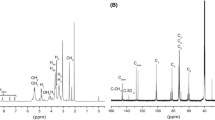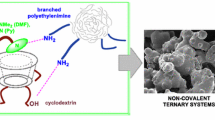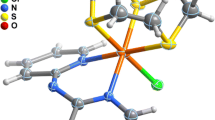Abstract
The synthesis of a series of star-shaped C 3 -symmetric amines and their inclusion complexation properties toward α-, β-, γ-cyclodextrins and their permethylated derivatives has been described. The star molecules comprise of 1,3,5-trisubstited benzene core and the points formed by (alkylamino)methyl or 4-((alkylamino)methyl)phenyl groups. The modes of host–guest interaction were studied by UV–Vis spectroscopy, ITC, 1H NMR and 2D-NMR (NOESY). It was found that star molecules containing (tert-butylamino)methyl, (adamantan-1-ylamino)methyl, 4-((isopropylamino)methyl)phenyl, 4-((tert-butylamino)methyl)phenyl and protonated 4-((adamantan-1-ylamino)methyl)phenyl points form strong host–guest complexes with β-cyclodextrin. It was also proved that the largest C 3 -symmetric guest can form complexes with β-cyclodextrin with stoichiometry 3 which is required for construction of dendrimer supramolecular structures. None of the investigated amines forms a strong complex with permethylated cyclodextrins.









Similar content being viewed by others
References
Szejtli, J.: Introduction and general overview of cyclodextrin chemistry. Chem. Rev. 98, 1743–1753 (1998)
Khan, A.R., Forgo, P., Stine, K.J., D’Souza, V.T.: Methods for selective modifications of cyclodextrins. Chem. Rev. 98, 1977–1996 (1998)
Fielding, L., McKellar, S.C., Florence, A.J.: Precision studies in supramolecular chemistry: a 1H NMR study of hydroxymethoxyacetophenone/β-cyclodextrin complexes. Magn. Reson. Chem. 49, 405–412 (2011)
Entrena, A., Jaime, C.: Cyclodextrin inclusion complexes. molecular mechanics calculations on the modification of π-face selectivity†. J. Org. Chem. 62, 5923–5927 (1997)
Schneider, H.-J., Hacket, F., Rüdiger, V., Ikeda, H.: NMR studies of cyclodextrins and cyclodextrin complexes. Chem. Rev. 98, 1755–1785 (1998)
Tošner, Z., Aski, S.N., Kowalewski, J.: Rotational dynamics of adamantanecarboxylic acid in complex with β-cyclodextrin. J. Incl. Phenom. Macrocycl. Chem. 55, 59–70 (2006)
Stojanov, M., Wimmer, R., Larsen, K.L.: Study of the inclusion complexes formed between cetirizine and α-, β-, and γ-cyclodextrin and evaluation on their taste-masking properties. J. Pharm. Sci. 100, 3177–3185 (2011)
Guerrero-Martínez, A., Montoro, T., Viñas, M.H., Tardajos, G.: Complexation and chiral drug recognition of an amphiphilic phenothiazine derivative with β-cyclodextrin. J. Pharm. Sci. 97, 1484–1498 (2008)
Roik, N.V., Belyakova, L.A.: Thermodynamic, IR spectral and X-ray diffraction studies of the “β-cyclodextrin-para-aminobenzoic acid” inclusion complex. J. Incl. Phenom. Macrocycl. Chem. 69, 315–319 (2010)
Wenz, G., Han, B.-H., Müller, A.: Cyclodextrin Rotaxanes and Polyrotaxanes. Chem. Rev. 106, 782–817 (2006)
Harada, A., Takashima, Y., Yamaguchi, H.: Cyclodextrin-based supramolecular polymers. Chem. Soc. Rev. 38, 875–882 (2009)
Chen, Y., Zhang, Y.-M., Liu, Y.: Multidimensional nanoarchitectures based on cyclodextrins. Chem. Commun. 46, 5622–5633 (2010)
Ilioudis, C.A., Tocher, D.A., Steed, J.W.: A highly efficient, preorganized macrobicyclic receptor for halides based on ch··· and nh···anion interactions. J. Am. Chem. Soc. 126, 12395–12402 (2004)
Han, W., Liu, C., Jin, Z.: Aerobic ligand-free suzuki coupling reaction of aryl chlorides catalyzed byin situ generated palladium nanoparticles at room temperature. Adv. Synth. Catal. 350, 501–508 (2008)
Kathiresan, M., Walder, L., Ye, F., Reuter, H.: Viologen-based benzylic dendrimers: selective synthesis of 3,5-bis(hydroxymethyl)benzylbromide and conformational analysis of the corresponding viologen dendrimer subunit. Tetrahedron Lett. 51, 2188–2192 (2010)
Nakazaki, M., Yamamoto, K., Toya, T.: Syntheses and chemical characterization of tris-bridged [2.2.2]cyclophanes with a triphenylmethyl component. J. Org. Chem. 46, 1611–1615 (1981)
Wenz, G.: Influence of intramolecular hydrogen bonds on the binding potential of methylated β-cyclodextrin derivatives. Beilstein J. Org. Chem. 8, 1890–1895 (2012)
Rekharsky, M.V., Inoue, Y.: Complexation Thermodynamics of Cyclodextrins. Chem. Rev. 98, 1875–1918 (1998)
Ernst, R.R., Bodenhausen, G., Wokaun, A.: Principles of nuclear magnetic resonance in one and two dimensions. Clarendon Press, Oxford (1990)
Nakazono, K., Takashima, T., Arai, T., Koyama, Y., Takata, T.: High-yield One-pot synthesis of permethylated α-cyclodextrin-based polyrotaxane in hydrocarbon solvent through an efficient heterogeneous reaction. Macromolecules 43, 691–696 (2010)
Iannazzo, L., Vollhardt, K.P.C., Malacria, M., Aubert, C., Gandon, V.: Alkynylboronates and -boramides in coi- and RhI-catalyzed [2 + 2+2] cycloadditions: construction of oligoaryls through selective suzuki couplings. Eur. J. Org. Chem. 2011, 3283–3292 (2011)
Brunel, J., Mongin, O., Jutand, A., Ledoux, I., Zyss, J., Blanchard-Desce, M.: Propeller-shaped octupolar molecules derived from triphenylbenzene for nonlinear optics: synthesis and optical studies. Chem. Mater. 15, 4139–4148 (2003)
Acknowledgments
This work was supported by the Ministry of Education, Youth, and Sports of the Czech Republic (project No. MSM0021620857) and Grant Agency of the Czech Republic (project No. 13-01440S). Help of Dr. S. Filippov with ITC measurements is appreciated.
Author information
Authors and Affiliations
Corresponding author
Electronic supplementary material
Below is the link to the electronic supplementary material.
Rights and permissions
About this article
Cite this article
Bednaříková, T., Tošner, Z., Horský, J. et al. Synthesis of C 3 -symmetric tri(alkylamino) guests and their interaction with cyclodextrins. J Incl Phenom Macrocycl Chem 81, 141–152 (2015). https://doi.org/10.1007/s10847-014-0443-1
Received:
Accepted:
Published:
Issue Date:
DOI: https://doi.org/10.1007/s10847-014-0443-1




